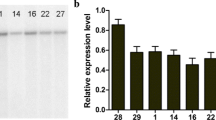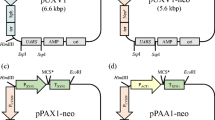Abstract
First-strand cDNA was prepared from mRNA isolated from Aspergillus kawachii IFO4308 and the β-xylanase gene (xynC) amplified by using the polymerase chain reaction (PCR) technique. This gene was inserted between the yeast phosphoglycerate kinase (PGK1) gene promoter (PGK1 p) and terminator (PGK1 T) sequences. The PGK1 P-xynC-PGK1 T construct (designated XYN3) was cloned into a multicopy episomal plasmid and the XYN3 gene was expressed in Saccharomyces cerevisiae. Functional β-xylanase (Xyn3) was produced and secreted by the recombinant yeast. Xyn3 was stable between 30 and 50°C, and the optimum temperature and pH were shown to be at 60°C and lower than pH3, respectively. An autoselective fur1::LEU2 XYN3 recombinant strain was developed that allowed β-xylanase production at a level of 300 nkat/ml in a non-selective complex medium.
Similar content being viewed by others
References
Bailey MJ, Biely P, Poutanen K (1992) Interlaboratory testing of methods of assay of xylanase activity. J Biotechnol 23: 257–270
Biely P (1985) Microbial xylanolytic systems. Trends Biotechnol 3: 286–290
Biely P, Mislovicová D, Toman R (1988) Remazol brilliant blue-xylan: a soluble chromogenic substrate for xylanases. Methods Enzymol 160: 536–541
Coughlan MP, Hazlewood GP (1993) β-1,4-D-Xylan-degrading enzyme systems: biochemistry, molecular biology and applications. Biotechnol Appl Biochem 17: 259–289
Farkas V, Lisková M, Biely P (1985) Novel media for detection of microbial producers of cellulase and xylanase. FEMS Microbiol Lett 28: 137–140
Filho EXF, Puls J, Coughlan MP (1993) Biochemical characteristics of two endo-β-1,4-xylanases produced by Penicillium capsulatum. J Industr Microbiol 11: 171–180
Fuller RS, Sterne RE, Thorner J (1988) Enzymes required for yeast prohormone processing. Annu Rev Physiol 50: 345–362
Graham H, Inborr J (1992) Applications of xylanase-based enzymes in commercial pig and poultry production. In: Visser J, Beldman G, Kusters-van Someren MA, Voragen AGJ (eds) Xylans and xylanases. Elsevier Science Publishers BV, Amsterdam, pp 535–538
Hessing JGM, van Rotterdam CO, Verbakel JMA, Roza M, Maat J, van Gorcom RFM, van den Hondel CAMJJ (1994) Isolation and characterization of a 1,4-β-endoxylanase gene of A. awamori. Curr Genet 26: 228–232
Hill J, Ian KA, Donald G, Griffiths DE (1991) DMSO-enhanced whole-cell yeast transformation. Nucleic Acids Res 19: 5791
Hill JE, Myers AM, Koerner TJ, Tzagoloff A (1986) Yeast/E. coli shuttle vectors with multiple unique restriction sites. Yeast 2: 163–167
Hoffman CS, Winston F (1987) A ten-minute DNA preparation from yeast efficiently releases autonomous plasmids for transformation of Escherichia coli. Gene 57: 267–272
Innis MA, Gelfand DH (1990) Optimizing of PCRs. In: Innis MA, Gelfand DH, Sninsky JJ, White TJ (eds) PCR protocols. Academic Press, San Diego, California, pp 3–12
Innis MA, Holland MJ, McCabe PC, Cole GE, Wittman VP, Tal R, Watt KWK, Gelfand DH, Holland JP, Meade JH (1985) Expression, glycosylation, and secretion of an Aspergillus glucoamylase by Saccharomyces cerevisiae. Science 228: 21–26
Ito K, Iwashita K, Iwano K (1992a) Cloning and sequencing of the xynC gene encoding acid xylanase of Aspergillus kawachii. Biosci Biotech Biochem 56: 1338–1340
Ito K, Ogasawara H, Sugimoto T, Ishikawa T (1992b) Purification and properties of acid stable xylanases from Aspergillus kawachii. Biosci Biotech Biochem 56: 547–550
Kern L, de Montigny J, Jund R, Lacroute F (1990) The FUR1 gene of Saccharomyces cerevisiae: cloning, structure and expression of wild-type and mutant alleles. Gene 88: 149–157
Kormelink FJM, Searle-Van Leeuwen MJF, Wood TM, Voragen AGJ (1993) Purification and characterization of three endo-(1,4)-β-xylanases and one β-xylosidase from Aspergillus awamori. J Biotechnol 27: 249–265
Kunkel TA, Roberts JD, Zakour RA (1987) Rapid and efficient sitespecific mutagenesis without phenotypic selection. Methods Enzymol 154: 365–382
Kyte J, Doolittle RF (1982) A simple method for displaying the hydropathic character of a protein. J Mol Biol 157: 105–132
Laemmli UK (1970) Cleavage of structural proteins during the assembly of the head of bacteriophage T4. Nature 227: 680–685
La Grange DC (1995) MSc thesis. University of Stellenbosch, Stellenbosch, South Africa
Laing E, Pretorius IS (1992) Synthesis and secretion of an Erwinia chrysanthemi pectate lyase in Saccharomyces cerevisiae regulated by different combination of bacterial and yeast promoter and signal sequences. Gene 121: 35–45
Loison G, Nguyen-Juilleret M, Alouani S, Marquet M (1986) Plasmid-transformed URA3 FUR1 double-mutants of S. cerevisiae: an autoselection system applicable to the production of foreign proteins. Bio/Technol 4: 433–437
Maat J, Roza M, Verbakel J, Stam H, Santos da Silva MJ, Bosse M, Egmond MR, Hagemans MLD, van Gorcom RFM, Hessing JGM, van den Hondel CAMJJ, van Rotterdam C (1992) Xylanases and their application in bakery. In: Visser J, Beldman G, Kusters-van Someren MA, Voragen AGJ (eds) Xylans and xylanases. Elsevier Science Publishers BV, Amsterdam, pp 349–360
Mikami S, Iwano K, Shiionki S, Shimada T (1987) Purification and some properties of acid-stable α-amylase from Shochu koji (Aspergíllus kawachii). Agric Biol Chem 51: 2495–2501
Miller GL, Blum R, Glennon WE, Burton AL (1960) Measurement of caboxymethylcellulase activity. Anal Biochem 2: 127–132
Morosoli R, Zalce E, Moreau A, Durand S (1992) Secretion of a xylanase from Cryptococcus albidus by Saccharomyces cerevisiae and Pichia stipitis. In: Visser J, Beldman G, Kusters-van Someren MA, Voragen AGJ (eds) Xylans and xylanases. Elsevier Science Publishers BV, Amsterdam, pp 247–258
Nissen AM, Anker L, Munk N, Lange NK (1992) Xylanases for the pulp and paper industry. In: Visser J, Kusters-van Someren MA, Beldman G, Voragen AGJ (eds) Xylans and xylanases. Elsevier Science Publishers BV, Amsterdam, pp 325–337
Okada H (1990) Expression of the xylanase gene of Bacillus pumilus in Escherichia coli, B. subtilis and Saccharomyces cerevisiae. In: Nga BH, Lee YK (eds) Microbiology applications in food biotechnology. Elsevier Science Publishers, New York, pp 1–12
Olson MV, Dutchik JE, Graham MY, Brodeur GM, Helms C, Frank M, MacCollin M, Scheinman R, Frank T (1986) Random-clone strategy for genomic restriction mapping in yeast. Proc Natl Acad Sci USA 83: 7826–7830
Poutanen K, Rättö M, Puls J, Viikari L (1987) Evaluation of different microbial xylanolytic systems. J Biotechnology 6: 49–60
Puls J, Schuseil J (1993) Chemistry of hemicelluloses: relationship between hemicellulose structure and enzymes required for hydrolysis. In: Coughlan MP, Hazlewood GP (eds) Hemicellulose and hemicellulases. Portland Press, London, pp 1–27
Romanos MA, Scorer CA, Clare JJ (1992) Foreign gene expression in yeast: a review. Yeast 8: 423–488
Rothstein RJ (1983) One-step gene disruption in yeast. Methods Enzymol 101: 202–211
Saiki RK, Gelfand DH, Stoffel S, Scharf SJ, Higuchi R, Horn GT, Mullis KB, Erlich HA (1988) Primer-directed enzymatic amplification of DNA with a thermostable DNA polymerase. Science 239: 487–491
Sambrook J, Fritsch EF, Maniatis T (1989) Molecular cloning: a laboratory manual, 2nd edn. Cold Spring Harbor Laboratory, Cold Spring Harbor, New York
Thomson JA (1993) Molecular biology of xylan degradation. FEMS Microbiol Rev 104: 65–82
Törönnen A, Mach RL, Messner R, Gonzalez R, Kalkkinen N, Harkki A, Kubicek CP (1992) The two major xylanases from Trichoderma reesei: characterization of both enzymes and genes. Bio/Technol 10: 1461–1465
Vieira J, Messing J (1982) The pUC plasmids, an M13mp7-derived system for insertion mutagenesis and sequencing with synthetic universal primers. Gene 19: 259–268
Wong KKY, Saddler JN (1992) Trichoderma xylanases, their properties and application. CRC Crit Rev Biotechnol 12: 413–435
Wong KKY, Saddler JN (1993) Applications of hemicellulases in the food, feed, and pulp and paper industries. In: Coughlan MP, Hazlewood GP (eds) Hemicellulose and hemicellulases. Portland Press, London, pp 127–143
Wong KKY, Tan LUL, Saddler JN (1988) Multiplicity of β-1,4-xylanase in microorganisms: functions and applications. Microbiol Rev 52: 305–317
Author information
Authors and Affiliations
Additional information
Communicated by F.K.Zimmermann
Rights and permissions
About this article
Cite this article
Crous, J.M., Pretorius, I.S. & van Zyl, W.H. Cloning and expression of an Aspergillus kawachii endo-1,4-β-xylanase gene in Saccharomyces cerevisiae . Curr Genet 28, 467–473 (1995). https://doi.org/10.1007/BF00310817
Received:
Issue Date:
DOI: https://doi.org/10.1007/BF00310817




